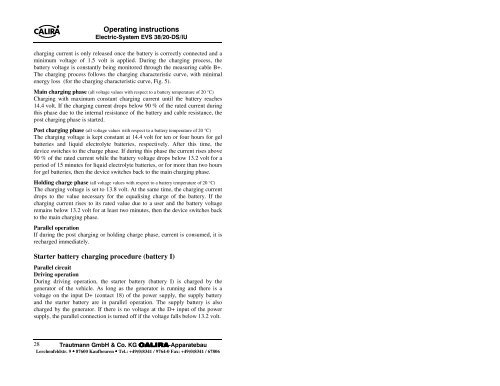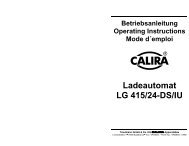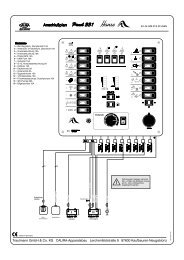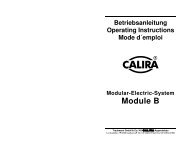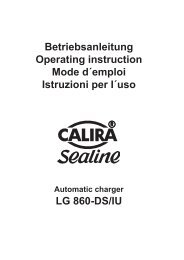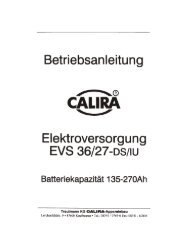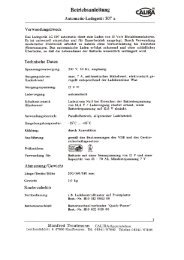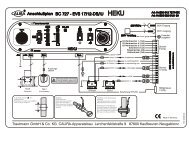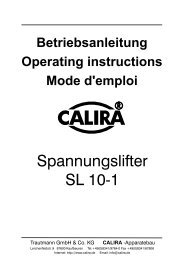Electric-System EVS 38/20-DS/IU - Calira
Electric-System EVS 38/20-DS/IU - Calira
Electric-System EVS 38/20-DS/IU - Calira
You also want an ePaper? Increase the reach of your titles
YUMPU automatically turns print PDFs into web optimized ePapers that Google loves.
' & "<br />
charging current is only released once the battery is correctly connected and a<br />
minimum voltage of 1.5 volt is applied. During the charging process, the<br />
battery voltage is constantly being monitored through the measuring cable B+.<br />
The charging process follows the charging characteristic curve, with minimal<br />
energy loss (for the charging characteristic curve, Fig. 5).<br />
Main charging phase (all voltage values with respect to a battery temperature of <strong>20</strong> °C)<br />
Charging with maximum constant charging current until the battery reaches<br />
14.4 volt. If the charging current drops below 90 % of the rated current during<br />
this phase due to the internal resistance of the battery and cable resistance, the<br />
post charging phase is started.<br />
Post charging phase (all voltage values with respect to a battery temperature of <strong>20</strong> °C)<br />
The charging voltage is kept constant at 14.4 volt for ten or four hours for gel<br />
batteries and liquid electrolyte batteries, respectively. After this time, the<br />
device switches to the charge phase. If during this phase the current rises above<br />
90 % of the rated current while the battery voltage drops below 13.2 volt for a<br />
period of 15 minutes for liquid electrolyte batteries, or for more than two hours<br />
for gel batteries, then the device switches back to the main charging phase.<br />
Holding charge phase (all voltage values with respect to a battery temperature of <strong>20</strong> °C)<br />
The charging voltage is set to 13.8 volt. At the same time, the charging current<br />
drops to the value necessary for the equalising charge of the battery. If the<br />
charging current rises to its rated value due to a user and the battery voltage<br />
remains below 13.2 volt for at least two minutes, then the device switches back<br />
to the main charging phase.<br />
Parallel operation<br />
If during the post charging or holding charge phase, current is consumed, it is<br />
recharged immediately.<br />
Starter battery charging procedure (battery I)<br />
Parallel circuit<br />
Driving operation<br />
During driving operation, the starter battery (battery I) is charged by the<br />
generator of the vehicle. As long as the generator is running and there is a<br />
voltage on the input D+ (contact 18) of the power supply, the supply battery<br />
and the starter battery are in parallel operation. The supply battery is also<br />
charged by the generator. If there is no voltage at the D+ input of the power<br />
supply, the parallel connection is turned off if the voltage falls below 13.2 volt.<br />
28<br />
! "#$ %&&<br />
Lerchenfeldstr. 9 87600 Kaufbeuren Tel.: +49(0)8341 / 9764-0 Fax: +49(0)8341 / 67806


